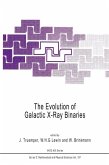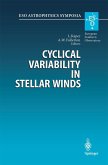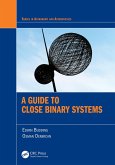Close Binaries in the 21st Century: New Opportunities and Challenges (eBook, PDF)
Redaktion: Gimenez, Alvaro; Rucinski, Slavek; Niarchos, Panagiotis; Guinan, Edward


Alle Infos zum eBook verschenken

Close Binaries in the 21st Century: New Opportunities and Challenges (eBook, PDF)
Redaktion: Gimenez, Alvaro; Rucinski, Slavek; Niarchos, Panagiotis; Guinan, Edward
- Format: PDF
- Merkliste
- Auf die Merkliste
- Bewerten Bewerten
- Teilen
- Produkt teilen
- Produkterinnerung
- Produkterinnerung

Hier können Sie sich einloggen

Bitte loggen Sie sich zunächst in Ihr Kundenkonto ein oder registrieren Sie sich bei bücher.de, um das eBook-Abo tolino select nutzen zu können.
An International Conference entitled "Close Binaries in the 21 st Century: New Opportunities and Challenges", was held in Syros island, Greece, from 27 to 30 June, 2005.
There are many binary star systems whose components are so close together, that they interact in various ways. Stars in such systems do not pass through all stages of their evolution independently of each other; in fact their evolutionary path is significantly affected by their companions. Processes of interaction include gravitational effects, mutual irradiation, mass exchange, mass loss from the system, phenomena of…mehr
- Geräte: PC
- ohne Kopierschutz
- eBook Hilfe
- Größe: 14.46MB
![Interacting Binaries (eBook, PDF) Interacting Binaries (eBook, PDF)]() S. N. ShoreInteracting Binaries (eBook, PDF)73,95 €
S. N. ShoreInteracting Binaries (eBook, PDF)73,95 €![The Evolution of Galactic X-Ray Binaries (eBook, PDF) The Evolution of Galactic X-Ray Binaries (eBook, PDF)]() The Evolution of Galactic X-Ray Binaries (eBook, PDF)113,95 €
The Evolution of Galactic X-Ray Binaries (eBook, PDF)113,95 €![Cataclysmic Variables and Low-Mass X-Ray Binaries (eBook, PDF) Cataclysmic Variables and Low-Mass X-Ray Binaries (eBook, PDF)]() Cataclysmic Variables and Low-Mass X-Ray Binaries (eBook, PDF)40,95 €
Cataclysmic Variables and Low-Mass X-Ray Binaries (eBook, PDF)40,95 €![The Electromagnetic Spectrum of Neutron Stars (eBook, PDF) The Electromagnetic Spectrum of Neutron Stars (eBook, PDF)]() The Electromagnetic Spectrum of Neutron Stars (eBook, PDF)233,95 €
The Electromagnetic Spectrum of Neutron Stars (eBook, PDF)233,95 €![Solar Journey: The Significance of Our Galactic Environment for the Heliosphere and Earth (eBook, PDF) Solar Journey: The Significance of Our Galactic Environment for the Heliosphere and Earth (eBook, PDF)]() Solar Journey: The Significance of Our Galactic Environment for the Heliosphere and Earth (eBook, PDF)113,95 €
Solar Journey: The Significance of Our Galactic Environment for the Heliosphere and Earth (eBook, PDF)113,95 €![Cyclical Variability in Stellar Winds (eBook, PDF) Cyclical Variability in Stellar Winds (eBook, PDF)]() Cyclical Variability in Stellar Winds (eBook, PDF)40,95 €
Cyclical Variability in Stellar Winds (eBook, PDF)40,95 €![A Guide to Close Binary Systems (eBook, PDF) A Guide to Close Binary Systems (eBook, PDF)]() Edwin BuddingA Guide to Close Binary Systems (eBook, PDF)186,95 €
Edwin BuddingA Guide to Close Binary Systems (eBook, PDF)186,95 €-
-
-
There are many binary star systems whose components are so close together, that they interact in various ways. Stars in such systems do not pass through all stages of their evolution independently of each other; in fact their evolutionary path is significantly affected by their companions. Processes of interaction include gravitational effects, mutual irradiation, mass exchange, mass loss from the system, phenomena of extended atmospheres, semi-transparent atmospheric clouds, variable thickness disks and gas streams.
The zoo of Close Binary Systems includes: Close Eclipsing Binaries (Detached, Semi-detached, Contact), High and Low-Mass X-ray Binaries, Cataclysmic Variables, RS CVn systems, Pulsar Binaries and Symbiotic Stars. The study of these binaries triggered the development of new branches of astrophysics dealing with the structure and evolution of close binaries and the interaction effects displayed by these exciting objects. Close Binaries are classic examples of the fundamental contribution that stellar astrophysics makes to our general understanding of physical processes in the universe.
Ground-based and space surveys will discover many new close binaries, which were previously unknown. In the future, new approaches will also be possible with highly efficient photometric searches looking for very shallow eclipses, such as those produced by Earth-like extra-solar planets.
Contributions to this conference covered the latest achievements in the field and reflected the state of the art of the dynamically evolving area of binary star research.
Dieser Download kann aus rechtlichen Gründen nur mit Rechnungsadresse in A, B, BG, CY, CZ, D, DK, EW, E, FIN, F, GR, HR, H, IRL, I, LT, L, LR, M, NL, PL, P, R, S, SLO, SK ausgeliefert werden.
- Produktdetails
- Verlag: Springer-Verlag GmbH
- Seitenzahl: 401
- Erscheinungstermin: 5. April 2007
- Englisch
- ISBN-13: 9781402050275
- Artikelnr.: 37349104
- Verlag: Springer-Verlag GmbH
- Seitenzahl: 401
- Erscheinungstermin: 5. April 2007
- Englisch
- ISBN-13: 9781402050275
- Artikelnr.: 37349104







